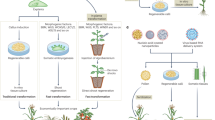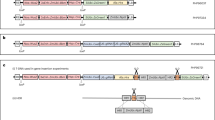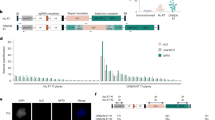Abstract
Agricultural biotechnology is limited by the inefficiencies of conventional random mutagenesis and transgenesis. Because targeted genome modification in plants has been intractable1, plant trait engineering remains a laborious, time-consuming and unpredictable undertaking. Here we report a broadly applicable, versatile solution to this problem: the use of designed zinc-finger nucleases (ZFNs) that induce a double-stranded break at their target locus2. We describe the use of ZFNs to modify endogenous loci in plants of the crop species Zea mays. We show that simultaneous expression of ZFNs and delivery of a simple heterologous donor molecule leads to precise targeted addition of an herbicide-tolerance gene at the intended locus in a significant number of isolated events. ZFN-modified maize plants faithfully transmit these genetic changes to the next generation. Insertional disruption of one target locus, IPK1, results in both herbicide tolerance and the expected alteration of the inositol phosphate profile in developing seeds. ZFNs can be used in any plant species amenable to DNA delivery; our results therefore establish a new strategy for plant genetic manipulation in basic science and agricultural applications.
This is a preview of subscription content, access via your institution
Access options
Subscribe to this journal
Receive 51 print issues and online access
$199.00 per year
only $3.90 per issue
Buy this article
- Purchase on Springer Link
- Instant access to full article PDF
Prices may be subject to local taxes which are calculated during checkout



Similar content being viewed by others
References
Puchta, H. Gene replacement by homologous recombination in plants. Plant Mol. Biol. 48, 173–182 (2002)
Carroll, D. Progress and prospects: zinc-finger nucleases as gene therapy agents. Gene Ther. 15, 1463–1468 (2008)
Iida, S. & Terada, R. Modification of endogenous natural genes by gene targeting in rice and other higher plants. Plant Mol. Biol. 59, 205–219 (2005)
Kim, Y. G., Cha, J. & Chandrasegaran, S. Hybrid restriction enzymes: zinc finger fusions to Fok I cleavage domain. Proc. Natl Acad. Sci. USA 93, 1156–1160 (1996)
Puchta, H. The repair of double-strand breaks in plants: mechanisms and consequences for genome evolution. J. Exp. Bot. 56, 1–14 (2005)
Jasin, M. Genetic manipulation of genomes with rare-cutting endonucleases. Trends Genet. 12, 224–228 (1996)
Bibikova, M. et al. Stimulation of homologous recombination through targeted cleavage by chimeric nucleases. Mol. Cell. Biol. 21, 289–297 (2001)
Porteus, M. H. & Baltimore, D. Chimeric nucleases stimulate gene targeting in human cells. Science 300, 763 (2003)
Wright, D. A. et al. High-frequency homologous recombination in plants mediated by zinc-finger nucleases. Plant J. 44, 693–705 (2005)
Cai, C. Q. et al. Targeted transgene integration in plant cells using designed zinc finger nucleases. Plant Mol. Biol. 69, 699–709 (2008)
Miller, J., McLachlan, A. D. & Klug, A. Repetitive zinc-binding domains in the protein transcription factor IIIA from Xenopus oocytes. EMBO J. 4, 1609–1614 (1985)
Pavletich, N. P. & Pabo, C. O. Zinc finger-DNA recognition: crystal structure of a Zif268-DNA complex at 2.1 Å. Science 252, 809–817 (1991)
Isalan, M. & Choo, Y. Rapid, high-throughput engineering of sequence-specific zinc finger DNA-binding proteins. Methods Enzymol. 340, 593–609 (2001)
Pabo, C. O., Peisach, E. & Grant, R. A. Design and selection of novel Cys2his2 zinc finger proteins. Annu. Rev. Biochem. 70, 313–340 (2001)
Sun, Y. et al. Inositol 1,3,4,5,6-pentakisphosphate 2-kinase from maize: molecular and biochemical characterization. Plant Physiol. 144, 1278–1291 (2007)
Raboy, V. Seeds for a better future: ‘low phytate’ grains help to overcome malnutrition and reduce pollution. Trends Plant Sci. 6, 458–462 (2001)
Stevenson-Paulik, J. et al. Generation of phytate-free seeds in Arabidopsis through disruption of inositol polyphosphate kinases. Proc. Natl Acad. Sci. USA 102, 12612–12617 (2005)
Raboy, V. myo-Inositol-1,2,3,4,5,6-hexakisphosphate. Phytochemistry 64, 1033–1043 (2003)
Urnov, F. D. et al. Highly efficient endogenous human gene correction using designed zinc-finger nucleases. Nature 435, 646–651 (2005)
Gordon-Kamm, W. J. et al. Transformation of maize cells and regeneration of fertile transgenic plants. Plant Cell 2, 603–618 (1990)
Frame, B. R. et al. Agrobacterium tumefaciens-mediated transformation of maize embryos using a standard binary vector system. Plant Physiol. 129, 13–22 (2002)
Doyon, Y. et al. Heritable targeted gene disruption in zebrafish using designed zinc-finger nucleases. Nature Biotechnol. 26, 702–708 (2008)
Bibikova, M. et al. Targeted chromosomal cleavage and mutagenesis in Drosophila using zinc-finger nucleases. Genetics 161, 1169–1175 (2002)
Lloyd, A. et al. Targeted mutagenesis using zinc-finger nucleases in Arabidopsis . Proc. Natl Acad. Sci. USA 102, 2232–2237 (2005)
Porteus, M. H. Mammalian gene targeting with designed zinc finger nucleases. Mol. Ther. 13, 438–446 (2006)
Moehle, E. A. et al. Targeted gene addition into a specified location in the human genome using designed zinc finger nucleases. Proc. Natl Acad. Sci. USA 104, 3055–3060 (2007)
Lombardo, A. et al. Gene editing in human stem cells using zinc finger nucleases and integrase-defective lentiviral vector delivery. Nature Biotechnol. 25, 1298–1306 (2007)
Perez, E. E. et al. Establishment of HIV-1 resistance in CD4+ T cells by genome editing using zinc-finger nucleases. Nature Biotechnol. 26, 808–816 (2008)
Wei, F. et al. Physical and genetic structure of the maize genome reflects its complex evolutionary history. PLoS Genet. 3, e123 (2007)
Maeder, M. L. et al. Rapid “open-source” engineering of customized zinc-finger nucleases for highly efficient gene modification. Mol. Cell 31, 294–301 (2008)
Isalan, M., Klug, A. & Choo, Y. A rapid, generally applicable method to engineer zinc fingers illustrated by targeting the HIV-1 promoter. Nature Biotechnol. 19, 656–660 (2001)
Doyon, Y. et al. Heritable targeted gene disruption in zebrafish using designed zinc-finger nucleases. Nature Biotechnol. 26, 702–708 (2008)
Maddaloni, M. et al. The sequence of the zein regulatory gene opaque-2 (O2) of Zea mays . Nucleic Acids Res. 17, 7532 (1989)
Fang, J. et al. Stable antibody expression at therapeutic levels using the 2A peptide. Nature Biotechnol. 23, 584–590 (2005)
Miller, J. C. et al. An improved zinc-finger nuclease architecture for highly specific genome editing. Nature Biotechnol. 25, 778–785 (2007)
Christensen, A. H., Sharrock, R. A. & Quail, P. H. Maize polyubiquitin genes: structure, thermal perturbation of expression and transcript splicing, and promoter activity following transfer to protoplasts by electroporation. Plant Mol. Biol. 18, 675–689 (1992)
McElroy, D., Zhang, W., Cao, J. & Wu, R. Isolation of an efficient actin promoter for use in rice transformation. Plant Cell 2, 163–171 (1990)
Wohlleben, W. et al. Nucleotide sequence of the phosphinothricin N-acetyltransferase gene from Streptomyces viridochromogenes Tü494 and its expression in Nicotiana tabacum . Gene 70, 25–37 (1988)
Sambrook, J., Fritsch, E. F. & Maniatis, T. Molecular Cloning: a Laboratory Manual 2nd edn (Cold Spring Harbor Laboratory Press, 1989)
Livak, K. J. & Schmittgen, T. D. Analysis of relative gene expression data using real-time quantitative PCR and the 2 - ΔΔ C t method. Methods 25, 402–408 (2001)
Armstrong, C., Green, C. & Phillips, R. Development and availability of germplasm with high type II culture formation response. Maize Genet. Coop. News Lett. 65, 92–93 (1991)
Petolino, J. F., Hopkins, N. L., Kosegi, B. D. & Skokut, M. Whisker-mediated transformation of embryogenic callus of maize. Plant Cell Rep. 19, 781–786 (2000)
Skoglund, E., Carlsson, N.-G. & Sandberg, A.-S. Determination of isomers of inositol mono- to hexaphosphates in selected foods and intestinal contents using high-performance ion chromatography. J. Agric. Food Chem. 45, 431–436 (1997)
Stevenson-Paulik, J. et al. Generation of phytate-free seeds in Arabidopsis through disruption of inositol polyphosphate kinases. Proc. Natl Acad. Sci. USA 102, 12612–12617 (2005)
Buscher, B. A. P., van der Hoeven, R. A. M., Tjaden, U. R., Andersson, E. & Van der Greef, J. Analysis of inositol phosphates and derivatives using capillary zone electrophoresis-mass spectrometry. J. Chromatogr. A 712, 235–243 (1995)
Hsu, F.-F., Turk, J. & Gross, M. L. Structural distinction among inositol phosphate isomers using high-energy and low-energy collisional-activated dissociation tandem mass spectrometry with electrospray ionization. J. Mass Spectrom. 38, 447–457 (2003)
Acknowledgements
The authors wish to thank numerous colleagues at Dow AgroSciences and Sangamo BioSciences for discussions regarding this project, the DAS Gamma group for statistics support, Sangamo’s production group for technical support and A. Klug for a critical reading of the manuscript. We are also grateful to W. Kleschick, D. Kittle and E. Lanphier for encouragement.
Author information
Authors and Affiliations
Corresponding author
Ethics declarations
Competing interests
The authors are current or recent employees of Dow AgroSciences, LLC, a wholly owned subsidiary of the Dow Chemical Company, or Sangamo BioSciences. These companies may gain or lose financially through this publication. The authors may also own stocks or shares in companies including the Dow Chemical Company and Sangamo BioSciences, that may gain or lose financially through publication of this article. Several authors are inventors on patents or patent applications whose value may be affected by this publication.
Supplementary information
Supplementary Information
This file contains Supplementary Figures 1-5 with Legends, Supplementary Tables 1-6 and a Supplementary Discussion. (PDF 774 kb)
Rights and permissions
About this article
Cite this article
Shukla, V., Doyon, Y., Miller, J. et al. Precise genome modification in the crop species Zea mays using zinc-finger nucleases. Nature 459, 437–441 (2009). https://doi.org/10.1038/nature07992
Received:
Accepted:
Published:
Issue Date:
DOI: https://doi.org/10.1038/nature07992
This article is cited by
-
Precise integration of large DNA sequences in plant genomes using PrimeRoot editors
Nature Biotechnology (2024)
-
An Overview of Targeted Genome Editing Strategies for Reducing the Biosynthesis of Phytic Acid: an Anti-nutrient in Crop Plants
Molecular Biotechnology (2024)
-
Genome editing in cotton: challenges and opportunities
Journal of Cotton Research (2023)
-
Regulation of gene-edited plants in Europe: from the valley of tears into the shining sun?
aBIOTECH (2023)
-
Phytoextraction Potential of Chrysanthemum and Cumbu Napier Hybrid Grass to Remediate Chromium-Contaminated Soils Using Bioamendments
International Journal of Environmental Research (2023)
Comments
By submitting a comment you agree to abide by our Terms and Community Guidelines. If you find something abusive or that does not comply with our terms or guidelines please flag it as inappropriate.



